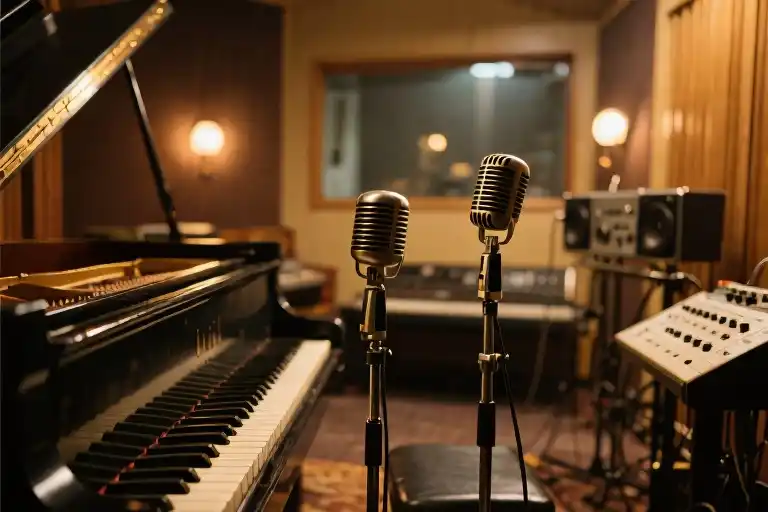The dusty dashboard of Roger Branch’s station wagon vibrated with the hum of tires on Highway 61 as the skyline of New Orleans emerged like a mirage. In his rearview mirror lay the remains of his life with The Tempests – the R&B band he’d founded, the East Coast club circuits they’d conquered, and the comfortable predictability of performing the same hits night after night. Ahead pulsed the magnetic energy of a city where music didn’t just live in venues, but seeped from the cracks in the sidewalks, the rusted balcony railings, and the steam rising from manhole covers.
New Orleans in the early 1970s wasn’t merely a destination; it was a gravitational force that had pulled generations of Southern musicians into its creative orbit. For Branch, the transition from bandleader to sound engineer wasn’t just a career shift – it was answering what Allen Toussaint would later call “the Mississippi River’s whisper,” that indefinable current that turned technical skill into alchemy. The same streets where Jelly Roll Morton once peddled piano rolls now housed recording studios where producers like Toussaint and Marshall Sehorn were rewriting the rules of R&B production.
What Branch couldn’t have known during that first drive past the shotgun houses of the Ninth Ward was how profoundly this city’s musical DNA would reshape his understanding of sound. New Orleans R&B didn’t follow the rulebooks of Motown’s assembly line perfection or Stax’s gritty spontaneity. Here, the collision of honky-tonk piano runs with Creole rhythms, of Baptist church harmonies with second-line brass bands, created something that recording meters couldn’t quantify and charts couldn’t categorize. The very air smelled of damp sheet music and hot amplifier tubes, a perfume that had lured everyone from Fats Domino to Dr. John into surrendering to the city’s tempo.
As his car crossed into Orleans Parish, a song drifted from a corner bar’s open door – likely a Toussaint composition, though the piano’s cascading notes bore the fingerprints of a dozen other players who’d contributed to this sonic gumbo. The realization struck: in New Orleans, even the silences between notes carried history. This was where he’d learn that engineering wasn’t about capturing performances, but bottling lightning.
The Pilgrimage: Roger Branch and the Lure of New Orleans
Every musician knows that moment when the road forks unexpectedly. For Roger Branch, founder of the 1960s R&B band The Tempests, that pivotal turn came when the magnetic pull of New Orleans’ music scene redirected his career from performing to sound engineering. The city’s reputation as a sonic laboratory—where honky-tonk piano collided with Creole rhythms under the watchful eyes of legends like Allen Toussaint—proved irresistible to a craftsman seeking deeper musical truths.
Branch’s transition began during his early days at Reflection Sound in North Carolina, where he first honed his engineering skills. The studio became his classroom, teaching him how to capture the raw energy of live performance while polishing it into radio-ready gold. But it was through industry connections that he began forging relationships with two architects of the New Orleans R&B sound: producer Marshall Sehorn and the visionary Allen Toussaint.
Their first collaborative sessions in the early 1970s revealed the city’s creative alchemy. Branch would later recall walking into Sea-Saint Studio, where the air smelled of vintage tube amplifiers and Louisiana humidity, to witness Toussaint transforming a simple piano demo into a full arrangement with effortless precision. “Allen could hear the finished record in his head before we’d tracked a single instrument,” Branch noted in a 1998 interview. “His left hand carried the bassline like a second heartbeat while his right danced between gospel chords and barrelhouse runs—that was the New Orleans sound in one pair of hands.”
What made these sessions extraordinary wasn’t just technical prowess, but the cultural exchange they represented. Branch, raised on East Coast R&B traditions, found himself absorbing production techniques born from the Mississippi Delta’s blues and the Caribbean rhythms floating through the French Quarter. Toussaint became his unofficial mentor, demonstrating how to mic a piano to capture its wooden resonance or when to let a horn section’s natural bleed create spatial depth.
The Toussaint-Sehorn partnership operated with quiet efficiency during these years. While Sehorn handled business logistics, Toussaint focused on musical direction—a duality that allowed them to nurture artists like Lee Dorsey while maintaining rigorous production standards. Branch observed how their Sansu Enterprises label functioned as a creative greenhouse: songwriting, arranging, and tracking often happened consecutively in the same converted house on Napoleon Avenue, with musicians rotating through like extended family.
New Orleans’ collaborative spirit left an indelible mark on Branch’s approach. He adopted Toussaint’s philosophy of “serving the song”—whether that meant simplifying an overcrowded arrangement or amplifying cultural fingerprints like second-line snare patterns. Years later, these lessons would surface in Branch’s own productions, where the space between notes felt as intentional as the notes themselves, and every rhythm track carried faint echoes of the city that reshaped his career.
Architect of Sound: Allen Toussaint’s Golden Era
Few figures embodied the soul of New Orleans R&B like Allen Toussaint. By the time Roger Branch arrived in the early 1970s, Toussaint had already cemented his legacy as the city’s musical architect—a pianist who could weave honky-tonk barrelhouse energy with Creole rhythmic sophistication, a producer who treated the studio as his compositional canvas, and a businessman who understood how to package raw talent for national audiences.
The Alchemy of Southern Nights
Nowhere was Toussaint’s genius more evident than in his 1975 masterpiece Southern Nights. The song’s opening piano riff—a deceptively simple cascade of notes—immediately transports listeners to the Louisiana bayous. What sounds effortless actually showcases his signature techniques:
- Layered syncopation: The right hand plays a lilting melody while the left anchors it with a second-line parade rhythm (that distinctive boom-bap-boom-bap borrowed from funeral processions)
- Lyrical storytelling: Vignettes of “fireflies dancing like diamonds” and “cane fields stretching for miles” paint an intimate portrait of rural Louisiana
- Space as an instrument: Unlike Phil Spector’s wall-of-sound approach, Toussaint let silence between phrases breathe, creating what musicians call “the pocket”
“Allen made the piano talk in a dialect only New Orleans understood,” Branch recalled during a 1998 interview. “When he played, you heard church hymns, Bourbon Street strip joints, and Congo Square drum circles all at once.”
The Triple Crown: Artist, Producer, Entrepreneur
Toussaint’s career embodied a rare trifecta that often clashed:
- The Artist
- Released solo albums under pseudonyms like “Naomi Neville” (his mother’s name) to avoid overshadowing the artists he produced
- Stage fright plagued him for decades—he preferred crafting hits behind the scenes
- The Producer
- Developed a “first-take philosophy” at Cosimo Matassa’s famed J&M Studio, capturing spontaneous energy (Lee Dorsey’s Ya Ya was recorded in under 30 minutes)
- Pioneered the “songwriter-producer” model now standard in pop music
- The Businessman
- Co-founded Sansu Enterprises with Marshall Sehorn in 1965, retaining publishing rights—an unusual move that secured generational wealth
- Negotiated deals where he earned royalties per song rather than flat fees
This balancing act came at a cost. Toussaint once confessed to Rolling Stone: “Some days I’d produce three sessions, write four songs, then realize I hadn’t touched my own piano in weeks.” Yet this very tension fueled his creativity—the same way New Orleans’ contradictions (sacred and profane, structured and wild) birthed its sound.
The Toussaint Touch: Case Studies
Two productions exemplify his transformative approach:
1. Working in the Coal Mine (Lee Dorsey, 1966)
- Transformed a blues shuffle into a dance craze by:
- Adding Cuban clave rhythm (2-3 pattern) to the bassline
- Using trombone smears to mimic mining sirens
- Recording the track at half-speed for a heavier groove
2. Mother-in-Law (Ernie K-Doe, 1961)
- Turned a bitter complaint into a celebratory anthem via:
- Call-and-response vocals inspired by Baptist choirs
- Barroom piano triplets under the verses
- A sax solo that quoted a children’s jump-rope rhyme
These tracks didn’t just top charts—they became DNA for funk, hip-hop (Dr. Dre sampled Coal Mine in 1992), and even modern country. As Toussaint quipped: “In New Orleans, we don’t recycle—we resurrect.”
The Unseen Blueprint
What set Toussaint apart wasn’t just technical skill, but his philosophy:
- Serve the song: “If you notice the production, I’ve failed” was his mantra
- Hybridize respectfully: He studied Professor Longhair’s “rhumba-boogie” piano for years before adapting it
- Elevate collaborators: Sessions often became impromptu music lessons (Branch remembered him patiently explaining clave rhythms to drummers)
Decades later, these principles still guide producers from Mark Ronson to Questlove—proof that the architect’s blueprints remain timeless.
Hit Factory: The Toussaint-Sehorn Partnership
Behind every great artist often stands an unsung business visionary. For Allen Toussaint, that figure was Marshall Sehorn—a partnership that would redefine how New Orleans R&B reached the world. Their Sansu Enterprises became more than just a record label; it was a self-contained ecosystem where raw talent entered and polished hits emerged.
The Blueprint of Sansu Enterprises
What set Sansu apart wasn’t just Toussaint’s musical genius, but the seamless workflow they engineered:
- Artist Development: Scouting local bars and church choirs for distinctive voices (like Lee Dorsey’s gritty delivery)
- In-House Production: Toussaint’s arrangements transformed demos into radio-ready tracks at their own studios
- Strategic Distribution: Sehorn’s deals with major labels like Amy-Mala ensured national reach
This vertical integration predated modern “artist incubators” by decades. As Roger Branch recalled from observing sessions: “They’d have a songwriter’s demo by noon, basic tracks by dinner, and horns overdubbed before midnight—all under one roof.”
Case Study: The Meteoric Rise of Ya Ya
Lee Dorsey’s 1961 hit exemplifies the Toussaint-Sehorn magic:
- Discovery: Dorsey was a local auto body worker when Sehorn caught his impromptu performance at The Dew Drop Inn
- Production: Toussaint crafted the song’s playful call-and-response around Dorsey’s conversational delivery
- Arrangement: That iconic piano intro (just four descending notes) became New Orleans R&B’s signature sound
- Chart Impact: Peaked at #7 on Billboard Hot 100—rare for an indie label release at the time
The secret? Toussaint’s musical intuition paired with Sehorn’s marketing savvy. While competitors chased trends, Sansu artists set them.
The Business of Soul
Sehorn handled what Toussaint disliked—contracts, royalties, promotion. Their 50/50 split was revolutionary in an era when producers often exploited artists. This fairness built loyalty; artists like Irma Thomas recorded exclusively with them for years.
Their model influenced later hit factories (Motown, Stax) but retained a distinctly New Orleans flavor—less assembly line, more family gumbo pot. As Branch noted: “At other studios, musicians clocked in. At Sansu, they stayed for dinner and told stories between takes.”
Legacy Beyond the Charts
The partnership’s real triumph wasn’t just hits, but how they documented the city’s sound. Those Sansu sessions preserved:
- The push-pull between sacred and secular (gospel harmonies over barrelhouse piano)
- Neighborhood rhythms (second-line beats sneaking into love songs)
- Linguistic cadences (Toussaint’s lyrics mirrored Creole speech patterns)
When hip-hop producers sample Toussaint’s works today, they’re tapping into this cultural time capsule—one that might have been lost without Sehorn’s business acumen to sustain it.
Cultural Alchemy: The Ingredients of New Orleans R&B
New Orleans R&B didn’t emerge from a vacuum—it was a simmering pot of musical traditions that coalesced into something entirely unique. At the heart of this transformation were two foundational elements: the honky-tonk piano legacy and the second-line rhythms that pulsed through the city’s streets. These weren’t just techniques; they were cultural fingerprints that Allen Toussaint and his contemporaries would refine into a golden era of sound.
The Honky-Tonk Legacy: From Barrelhouses to Hit Records
The story begins with Professor Longhair—born Henry Roeland Byrd—whose left-hand bass patterns and right-hand flourishes created the blueprint for New Orleans piano. By the 1950s, this style had evolved in the city’s bars and juke joints into what became known as honky-tonk piano (a blues-based style emphasizing syncopation and repetitive riffs). Toussaint didn’t just adopt this approach; he elevated it. Listen to the opening bars of ‘Tipitina,’ and you’ll hear how he transformed barrelhouse improvisation into sophisticated arrangement—keeping the raw energy while adding compositional precision.
This evolution wasn’t accidental. As Roger Branch recalled from his sessions at Cosimo Matassa’s studio: “Allen could make a piano laugh or cry within the same measure. He’d take those honky-tonk rolls Professor Longhair pioneered and give them pop sensibility.” The proof lives in tracks like ‘Working in the Coal Mine,’ where Toussaint’s piano stabs mimic both factory machinery and Creole dance rhythms—a duality only possible in New Orleans.
Second-Line Rhythms: When Funeral Parades Met the Recording Studio
Nowhere is the city’s cultural alchemy more audible than in its treatment of rhythm. The so-called ‘second-line’ beat—originating from brass band funeral processions—became the backbone of classic R&B recordings. Characterized by its swung snare drum syncopation (often mimicking the ‘clave’ pattern of Afro-Caribbean music), this rhythm gave New Orleans R&B its signature bounce.
Toussaint’s genius lay in adapting these street rhythms for studio production. Take Lee Dorsey’s ‘Ya Ya’: the track’s seemingly simple groove actually layers three rhythmic traditions:
- Second-line snare: The “spank” on beats 2 and 4
- Caribbean clave: Implied in the hi-hat pattern
- Gospel shuffle: The piano’s push-and-pull timing
As Marshall Sehorn once noted, “We didn’t invent these grooves—we just bottled lightning from the streets.” This approach created what musicians now call the ‘NOLA pocket’—a rhythmic space that feels simultaneously loose and precise.
The Creole Connection: Where Europe Met Africa
Beneath these surface elements ran deeper cultural currents. Many forget that Toussaint was Creole—a heritage blending French, Spanish, and West African influences. This manifested in his arrangements through:
- Chord voicings: Jazz-influenced extended harmonies (9ths, 13ths) uncommon in early R&B
- Melodic phrasing: French folk song structures meeting blues pentatonics
- Lyrical themes: Storytelling that echoed both Delta blues and Parisian chanson
In ‘Southern Nights,’ these elements converge perfectly. The verses float with Impressionist harmony, while the chorus locks into a Fats Domino-style backbeat—a cultural dialogue spanning continents.
Why This Still Matters Today
Modern producers continue mining this legacy. From Dr. John’s voodoo-funk to Trombone Shorty’s brass-hop, the DNA of 1960s New Orleans R&B persists. Even in hip-hop, producers like Mannie Fresh sample Toussaint’s piano licks to anchor tracks with that unmistakable NOLA swing.
Perhaps Roger Branch put it best during a 2008 interview: “What Allen did wasn’t just make records—he bottled the soul of a city. Every time you hear a horn line that makes your shoulders shimmy or a piano riff that feels like beads flying at Mardi Gras, that’s the alchemy we’re talking about.”
Epilogue: The Beat Goes On
Roger Branch’s journey through the vibrant world of New Orleans R&B didn’t end with his early collaborations. His partnership with Allen Toussaint and Marshall Sehorn continued to flourish, culminating in his work on what would become one of Toussaint’s final albums. This project wasn’t just another studio session—it was a heartfelt tribute to the musical legacy they had all helped shape. Branch often recalled how Toussaint’s meticulous approach in those last recordings mirrored their first encounters decades earlier: every note, every silence, deliberately placed to tell a story only New Orleans could narrate.
For those who lived through it, the golden era of New Orleans R&B never truly faded. It simply evolved, finding new voices and fresh interpretations. Artists like Dr. John and Trombone Shorty became torchbearers, while hip-hop producers mined Toussaint’s catalog for samples, introducing his genius to younger audiences. Jay-Z’s use of Toussaint’s piano riffs in Hollywood stands as proof—the city’s musical DNA persists, adapting without losing its soul.
A Living Playlist
To experience this legacy firsthand, explore these essential Toussaint productions that defined an era:
- “Working in the Coal Mine” (Lee Dorsey): The quintessential blend of Creole rhythms and playful lyricism.
- “Southern Nights” (Glen Campbell version): Proof of Toussaint’s cross-genre appeal, transforming Louisiana dusk into melody.
- “Yes We Can Can” (The Pointer Sisters): A funk anthem with the loose-but-tight instrumentation that became his signature.
(Spotify playlist link: Essential Toussaint Productions)
As Branch reflected years later, leaning on the piano at Preservation Hall, the same spot where he’d first understood New Orleans’ magic, he smiled. “The music never leaves you,” he’d say. “It just waits for the next dreamer to pick up the beat.” And in the humid air, beneath the flickering gas lamps, the horns still wail—joyful, mournful, and utterly alive.
Epilogue: The Beat Goes On
New Orleans has always danced between joy and sorrow, a duality perfectly embodied in its jazz funerals where mournful dirges explode into celebratory second-line parades. This same spirit pulses through the R&B legacy left by Allen Toussaint and carried forward by torchbearers like Roger Branch.
Branch’s journey came full circle when he engineered Toussaint’s final studio sessions, those elegant fingers still coaxing honky-tonk flourishes from piano keys decades after their first collaboration. There’s poetry in how these men’s careers intertwined—the young sound technician from North Carolina who found his musical Mecca, and the Crescent City maestro who gifted the world a sound as rich as gumbo.
Today, you’ll hear Toussaint’s DNA in unexpected places: in the syncopated strut of Trombone Shorty’s brass section, in the sampled piano loops underpinning Kendrick Lamar’s beats, even in global pop hits channeling that unmistakable New Orleans bounce. The city’s musical alchemy—where church choirs blend with barroom revelry, where African polyrhythms waltz with French quadrilles—continues rewriting the rules of American music.
As the last trumpet wails at a jazz funeral, mourners raise their umbrellas in a defiant salute to life. So too does New Orleans R&B endure, its golden age preserved in vinyl grooves while new generations reinterpret its language. Press play on Toussaint’s “Southern Nights,” and suddenly the past isn’t history—it’s the foundation for whatever comes next.
(Explore the legacy with this Essential Toussaint Productions playlist—the perfect soundtrack for your own musical pilgrimage.)




